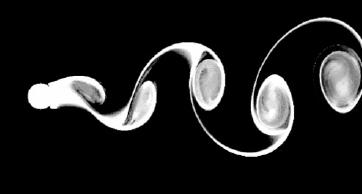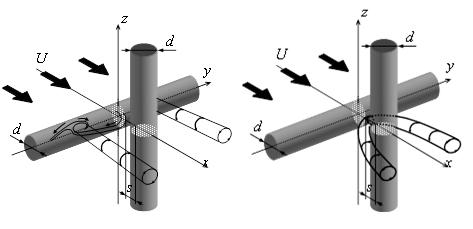The Takahashi laboratory is divided into two groups of wind group and Leo group according to the nature of the fluid. Each group is divided according to the research subject.
- Wind Team : Research on fluid related vibration for Newtonian fluid such as water and air.
- Rheology Team : Research on rheology (complex fluid) for non-Newtonian fluid such as surfactant, liquid crystal, polymer solution.
Wind Team・Vortex Excitation Group
Cruciform arrangement and vortex-induced vibration
When an object is placed in the flow, a vortex flowing out in turn called Karman vortex as shown in Fig. 1 is formed behind the object. This vortex periodically exerts a force on the object in a perpendicular direction to the flow. Vibration is occurred by the resonance phenomenon when the frequency due to the vortex is synchronized with the natural frequency of the object. Columnar and belt-like structures such as chimneys and bridges can cause destruction by this vibration. When constructing such a structure, it must have a shape that does not resonate with Karman vortex due to anticipated wind.
At the wind team of Takahashi-lab, by another object place to cross the column at the downstream of the columnar object, we succeeded in suppressing the vibration by the Karman vortex. We discovered that when the gap between two columnar objects is small, vibration by another vortex that is not a Karman vortex occurs. This new vortex is referred to as "longitudinal vortex" because the rotation axis of new vortex is the flow direction of the fluid.
Longitudinal vortex vibration is promised to be applied to wind / hydraulic vibration power generation, because the longitudinal vortex has greater fluid force than the Karman vortex and it has a wide flow velocity range that it vibrates. Two kinds of longitudinal vortexes (Fig. 2) flow out due to the parameter of the gap ratio s/d obtained by the gap s between the columnar objects by the diameter d of the behind columnar object. Trailing vortex when 0 < s/d < 0.25, Necklace vortex flows out when 0.25 ≤ s/d ≤ 0.5. Necklace vortex disappear when it exceeds a certain flow velocity in water. This phenomenon is not seen in the Trailing vortex, it is known from the previous research that it is unique to the Necklace vortex.
In recent years, it has been confirmed that galloping, a vibration phenomenon other than vortex excitation, occurs due to longitudinal vortices. While vortex excitation is a phenomenon generated by periodic Trailing vortices, galloping is generated by the steady force of the Necklace vortex. Galloping occurs at a higher flow rate than vortex excitation, resulting in large amplitude vibrations. A notable point in galloping of vertical vortices is that they also occur in cylinders. Normally, it occurs only in a prism that is not rotationally symmetric, but galloping by vertical vortices also occurs in a cylinder because the principle of lift is different. Through experiments in the wind tunnel, we will elucidate the characteristics of this new phenomenon.


